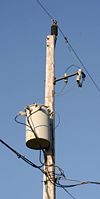
Photo from wikipedia
Single-phase earth faults in per-phase shielded cables of a 20-kV electrical network that is relatively new in Russia are studied experimentally. In contrast to the widely used 6- to 10-kV… Click to show full abstract
Single-phase earth faults in per-phase shielded cables of a 20-kV electrical network that is relatively new in Russia are studied experimentally. In contrast to the widely used 6- to 10-kV electrical network with an isolated or compensated neutral, the 20-kV network has low-resistance neutral grounding. Therefore, calculated conditions for substantiation and choice of nominal parameters of per-phase shielded cables for the 6- to 10- and 20-kV networks can significantly differ. It is shown that shielding for 6- to 10-kV cables is chosen for the case of a double-phase to earth fault (two phases connected with the earth), whereas, for 20-kV cables, this is a single-phase earth fault, which is significantly less strict with respect to thermal stability. Double-phase earth faults in 20 kV networks are practically excluded due to significantly lower levels of overloads in the network upon commutations and a comparatively short time (0.25–1.0 s) of faulted-line tripping. It is established experimentally that the single-phase earth fault in 20-kV per-phase shielded cables does not transforms to a multiphase earth fault. It is substantiated that the choice of shields for these cables based on the current of single-phase earth fault eases the requirements to thermal stability of the cables, which is of principal importance for lowering the cable production cost and power and energy losses in electrical networks.
Journal Title: Russian Electrical Engineering
Year Published: 2018
Link to full text (if available)
Share on Social Media: Sign Up to like & get
recommendations!